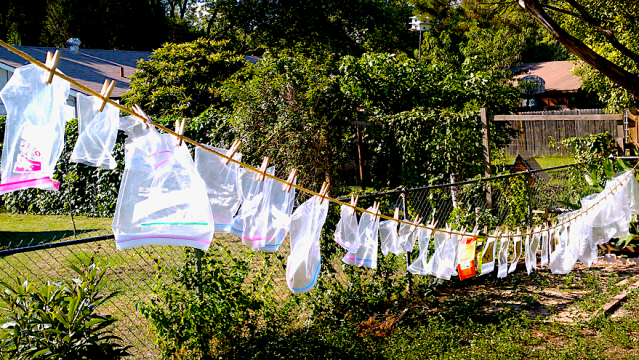Even if you do all your shopping with reusable bags, you’re going to end up with a bunch of plastic. Your bread comes in it, your toilet paper, your organic carrots and non-GMO freekeh from the bulk bin and no, it can’t be recycled with your bottles and cans. The same goes for all the plastic that swaddles your online purchases.
Go to the Grocery Store
But if your local grocery, drugstore, or big-box store has bins for recycling plastic bags, you’re in luck. Because those bins accept way more than just plastic shopping bags, including all kinds of stuff you’re probably currently throwing out, like dry cleaning bags, zipper storage bags, the plastic wrapping that goes around everything from diapers to six packs of soda; some kinds of clear quilted air-filled packaging that comes in shipping boxes, and padded plastic mailing envelopes from Amazon and their ilk.
Make It Easy
Grab one of the many plastic bags in your possession and stuff it somewhere convenient: maybe under your kitchen sink, by your regular recycling bin or trash can, or—ideally—inside one of your reusable grocery bags.
Fill it with all the recyclable plastic bags and films you’d otherwise throw out. When you grab your reusable bag to go to the store, grab your sack of discarded plastics, too, and take it straight to the bin. Done. A few less plastic things for turtles and fish to choke on, a little less fill for the landfill.
Check the Label
More packaging manufacturers are using a newish labeling system that makes it easy to figure out what the heck you can and cannot recycle in these in-store bins (just look for the “Store Drop-off” label), and where to do it. Participating stores include Target, Lidl, Wegmans, Lowe’s, Safeway, and Wal-Mart.

Comments
2 responses to “Quickly Reduce The Amount Of Plastic You Throw Away”
I’ve been playing Fallout 76.. I need all your plastic
Another poorly localised article. For example, Coles collects soft plastics and uses Redcycle, which accepts a whole manner of things over and above the list above. The thing that surprised me, which I learned from watching ABC’s War on Waste, is that chip packets are included:
http://www.redcycle.net.au/what-to-redcycle/
Biscuit packets (outer wrapper only)
Bread bags (without the tie)
Bubble wrap (large sheets cut into A3 size pieces)
Cat and dog food pouches (as clean and dry as possible)
Cellophane from bunches of flowers (cut into A3 size pieces)
Cereal box liners
Chip and cracker packets (silver lined)
Chocolate and snack bar wrappers
Cling Wrap – free of food residue
Confectionery bags
Dry pet food bags
Fresh produce bags
Frozen food bags
Green bags (Polypropylene Bags)
Ice cream wrappers
Large sheets of plastic that furniture comes wrapped in (cut into A3 size pieces)
Netting produce bags (any metal clips removed)
Newspaper and magazine wrap
Pasta bags
Plastic Australia Post satchels
Plastic carrier bags from all stores
Plastic film wrap from grocery items such as nappies and toilet paper
Plastic sachets
Potting mix and compost bags – both the plastic and woven polypropylene types (cut into A3 size pieces and free of as much product as possible)
Rice bags – both plastic and the woven type (if large, cut into A3 size pieces)
Snap lock bags / zip lock bags
Squeeze pouches with lid on (e.g. yogurt/baby food)
Wine bladders – clear plastic ones only